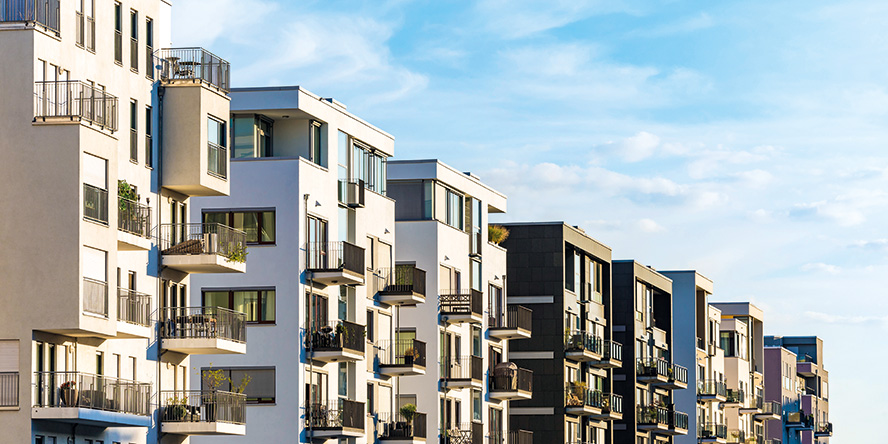Record investment
$478 billion Total investment in apartments globally in 2021.
30% Global investment in apartments exceeded that of offices by 30% in 2021.
The past couple of years, people have focused on the concept of home like never before – and the same is true for investors. Global investment in apartments hit a record high of more than $478 billion in 2021 and in Q3 investment exceeded offices for the first time. By the end of last year, investment volumes were 30% above offices.
This is in large part because residential property has performed well during the pandemic compared with office and retail, which had to manage rent collection difficulties due to lockdowns and remote working.
In most countries, total returns for residential in 2020 were 5.5%-8.3%, with only the industrial sector faring better.
The surge in investment in professionally managed apartment blocks, known as multifamily housing or build to rent, has driven prime net yields to record lows of 3% or less in most geographies. Even though multifamily is considered to have the highest value metrics, the yield spread over long-term bond yields remains attractive. This means prime yields may remain unchanged or even harden slightly further, despite interest rate hikes in the US and Europe, before starting to adjust upwards.
Record Low Yields
3% The surge in investment in multifamily housing has driven prime net yields to record lows of 3% or less in most geographies.
Crucially, sectors with defensive characteristics that benefit from macro factors such as demographic trends look increasingly attractive to investors seeking safe havens. During times of economic turbulence, demand for rental properties rises and multifamily housing provides investors with an attractive opportunity to diversify away from more cyclical real estate sectors and to continue to receive secure, inflation-hedged income streams in regions where residential rents are index-linked – typically in Europe.
The multifamily sector now
In North America and parts of Europe, the sector is large and mature. In Germany, multifamily accounted for 46% of property investment in 2021, 39% in the US and Ireland, 34% in Sweden and 30% in Canada.
Market size and liquidity depend on the share of the rental market that is institutionally owned. In the US, institutional ownership is around 40%, making it the world’s largest market.
Most active markets
46% The share of multifamily investment in Germany as proportion of total property investment. It was 39% in the US and Ireland, 34% in Sweden, 30% in Canada.
The biggest owner of multifamily blocks, MAA, has more than 100,000 homes. In Germany, roughly 13% of the rental apartment market is in the hands of large professional private owners, although this share rises, for example, to 29% in Berlin. In France, about 3% of the private rented sector (PRS) is institutionally owned; in Spain, it is 6%, underpinned by the recent entry of specialist players developing new multifamily products in response to rising demand from renters.
The UK has a small but growing market, with 3% of the PRS owned by institutions and a build to rent pipeline totalling 212,200 units complete, under construction or in planning.
Japan, where institutions own around 3% of the PRS, or around 450,000 homes, has been seeing a steady rise in international investment. The country’s residential sector has shown stable returns through the past 10 years, including a resilient performance during the global financial crisis – this was the driver for Blackstone to invest over $1.5 billion in 2014, which started the wave of international interest.
“Japan’s multifamily sector, which used to be unfashionable, is gaining more interest among institutional investors seeking markets where they can harbour capital for the long term with lower risk,” says Tetsuya Kaneko, Head of Research, Savills Japan. “Potential rental increases supported with positive demographic changes – i.e. urbanisation – are particularly attractive.”
What are the opportunities and risks?
Housing is a basic need. The demand for rental housing, especially affordable housing, can rise during periods of uncertainty, notably if stricter lending criteria slows demand in the sales market. Many markets in Europe and the US are also chronically undersupplied.
There are other strong demographic trends supporting the sector. The demand for rental accommodation has been driven by young people moving to urban centres for work and study and this is unlikely to be altered by Covid-19 in the long term. Even some cities such as Tokyo, which experienced population decline during the pandemic, saw occupancy rates start to increase again by the end of 2021. Barriers to home ownership, changing cultural norms and a better quality of housing product also mean renting has become a more desirable option for all age groups.
Yet the sector is not without risks, one of which is a more stringent regulatory environment designed to protect households from rising rents. “Many cities in Europe have introduced rent caps, which limit rental growth prospects for landlords,” says Marcus Roberts, Director, Operational Capital Markets, Savills. “However, rent caps also help investors by reducing the risk of frequent tenant turnover and providing higher income security.”
The share of average earnings spent on rent was already at historically high levels in the US and Europe before the pandemic and the squeeze on consumer incomes due to rising inflation and energy prices may have a further impact on rent affordability, limiting the extent to which landlords can increase rents. In the US, the consultancy Capital Economics forecasts effective rental growth to slow from 12.5% year-on-year at the end of 2021 to 4.0% by Q4 2022 and 1.5% by end-2025.
A further challenge for investors is the increasing operational intensity of rental assets. Post-pandemic, occupiers are spending more time at home and are focusing on wellness and convenience, with separate home office space now essential for some tenants. Following the lockdown experience, outdoor spaces and larger, operable windows have become a prerequisite, while heightened interest in safety and sanitation is likely to continue, leading to increased demand for touch-free technologies and more spacious communal areas.
Where could we go from here?
The low penetration rates of institutional ownership mean there is huge potential for institutions seeking stable income streams to grow their exposure to the sector, especially in Europe, where demand for rental is rising. We estimate the total value of the residential sector of 13 key European cities is more than $6.8trn. About 37% of this is rented and the majority is in apartment blocks.
Room for growth
22% In Australia, multifamily represented just 1% of total property investment in 2021. It was 3% in the UK, 13% in Japan, 15% in France and 21% in Spain, vs a global average of 22%.
Nascent markets such as Australia, which is expected to see strong growth over the next five years, also present opportunities. Recent research by Savills Australia found almost 70% of Local Government Authorities had fewer apartments available to rent in Q4 2021 compared with two years prior. This is pushing rental growth far above historic levels, while supply of new residential units is declining and property prices have soared, rising by a record average of 24% nationally in 2021.
Conal Newland, Head of Operational Capital Markets, Savills Australia, says: “The attention that build to rent is gaining is a direct result of increasing housing unaffordability, a slowdown in residential construction and the rapid expected bounce-back in migration, which is being encouraged by the federal government to stimulate economic growth and satisfy current skills shortages,” he says. “A number of major players such as Greystar are now investing in the market, with strong near-term rental growth prospects across the main capital cities a key investment driver.”
Institutional ownership of multifamily
$6.8 trillion The total value of the residential sector of 13 key European cities is more than $6.8trn
Creating sustainable communities
Investors targeting affordable homes can also help tackle the housing crisis. Offering energy-efficient and accessible housing promotes equality and creates sustainable communities, at the same time helping investors meet their impact investing goals – even more so if this involves the refurbishment and reuse of obsolete buildings in central locations.
The pandemic has highlighted the importance of the quality of our homes for our personal wellbeing, yet, at the same time, housing costs continue to outstrip wage increases. There is a significant opportunity for the public and private sectors to come together to increase the supply of affordable housing, improve public infrastructure, expand green spaces, renovate old buildings and adopt smart city solutions. Ultimately, investing in multifamily housing can be a force for good as well as a sound investment.



